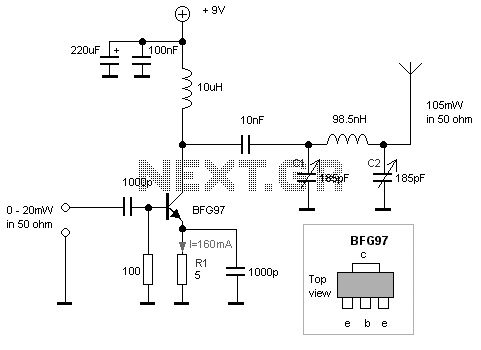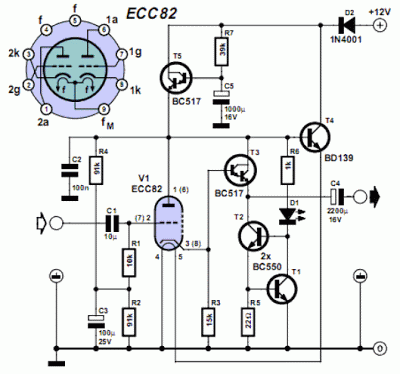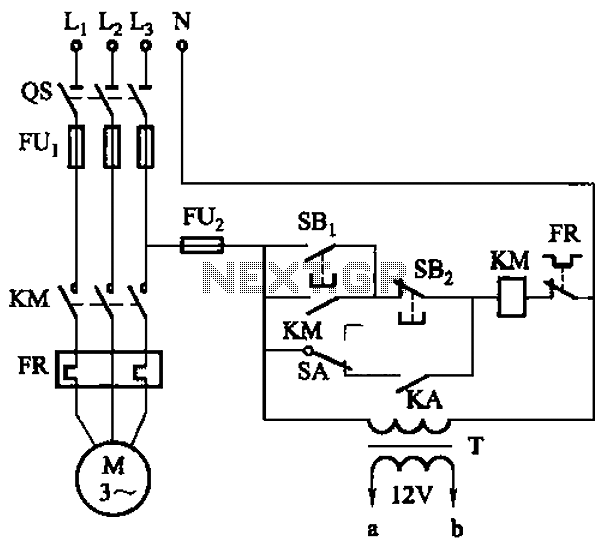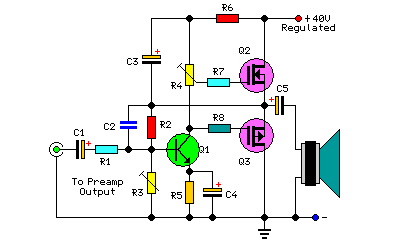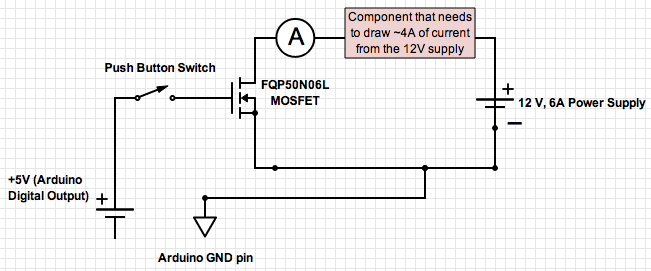
Mosfet Amplifier Circuits
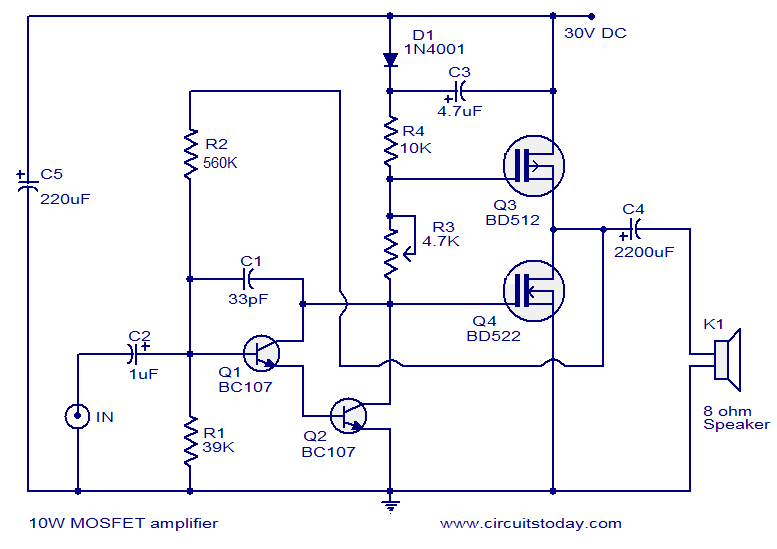
This article lists various types of audio amplifier circuits using MOSFETs. All circuits have been tested in a laboratory environment and have shown satisfactory performance. The amplifier utilizes one transistor, two MOSFETs, and a few resistors and capacitors in a shunt feedback configuration. This compact circuit can deliver up to 18 watts into an 8-ohm speaker or 30 watts into a 4-ohm speaker. To achieve such performance and stability with minimal components, a high-quality, well-regulated DC power supply is essential. This is crucial for minimizing noise and maintaining a consistent output power under varying loads. A suitable DC voltage regulator capable of providing more than 2 amps at 40 volts is recommended. A power supply design will be available soon in the power supply section. The circuit board should be assembled on a high-quality PCB. Utilizing a preamplifier board with tone control prior to this amplifier can enhance performance, although the amplifier itself is capable of delivering significant output without it. The provided diagram illustrates a 10-watt MOSFET audio amplifier circuit that requires only a single power supply. Single rail supply is rarely used in Class-B power amplifiers; however, it is adequate for low-power applications like this. The circuit was derived from an operational cassette player and is presented in its original form. The power MOSFETs BD512 and BD522 are now obsolete, and alternative matching power MOSFETs may be used. Transistors Q1 and Q2 are configured as a Darlington pair, functioning as the preamplifier. The preset resistor R3 regulates the quiescent current, while R2 provides feedback. The output is coupled to the speaker via capacitor C4. Capacitor C5 acts as a power supply filter, and C2 serves as the input DC decoupling capacitor. The first stage of the amplifier is a differential amplifier formed by transistors Q1 and Q2. Capacitor C8 functions as the input DC decoupler, R1 limits the input current, and capacitor C1 bypasses unwanted high frequencies. The second stage serves as the driver stage, comprising transistors Q3 and Q4. The output stage consists of a complementary push-pull configuration based on MOSFETs IRF530 and IRF9530. The output is coupled to the speaker through inductor L1. The network formed by R15 and C5 is designed for noise reduction. Capacitors C6 and C7 serve as power supply filters. The preset resistor R6 is used to adjust the quiescent current.
The audio amplifier circuit described utilizes a combination of transistors and MOSFETs to achieve efficient amplification of audio signals. The use of a single power supply simplifies the design, making it suitable for compact applications. The choice of a Darlington pair for the preamplifier stage enhances the input sensitivity and allows for better signal handling.
The differential amplifier configuration at the first stage ensures that the amplifier can effectively reject common-mode signals, improving overall sound quality. The inclusion of various capacitors, such as C1, C2, C4, C5, C6, C7, and C8, plays a crucial role in filtering and decoupling, which is vital for maintaining audio fidelity and reducing noise.
The complementary push-pull output stage, utilizing the IRF530 and IRF9530 MOSFETs, provides high output power while ensuring linearity and efficiency. The use of inductors, such as L1, in the output coupling stage helps to filter out any high-frequency noise that may be present in the output signal.
To optimize performance, it is essential to carefully select the components, particularly the power MOSFETs, to ensure they match the required specifications for the circuit. Proper assembly on a quality PCB will also contribute to the overall reliability and performance of the amplifier.
In summary, this audio amplifier circuit is a robust design that demonstrates effective use of MOSFET technology to achieve significant audio output with minimal components. The careful arrangement of stages and the use of feedback mechanisms contribute to its satisfactory performance in various audio applications.This article lists various types of audio amplifier circuits using Mosfet. We have tested all these circuits in our lab and we found all of them performing satisfactorily. The amplifier employs only one transistor and two MOSFETs and few resistors and capacitors in a shunt feedback scheme. This tiny circuit can can deliver a whopping 18Watts into 8 Ohm speaker or 30W into a 4 Ohm speaker. To get such a good performance and stability out of few components, a high quality well regulated DC power supply is necessary. This is very essential for reducing noise and getting a constant output power on varying loads. A good DC voltage regulator able of providing more than 2 Amps @ 40V can be used. You can expect such a power supply design very soon here in the power supply section. Assemble the board on a good quality PCB. Use a preamplifier board with tone control prior to this amplifier to get better performance. If you don`t want, then no problem because this amplifier circuit has enough punch with in it. The diagram shown here is of a 10W MOSFET audio amplifier circuit that requires only a single supply.
Single rail supply is seldom used in Class-B power amplifiers. Anyway, for low power applications like this it`s quite fine. Actually I got this circuit from an old cassette player that is still working and I am publishing it as it is. The powers MOSFETs BD512 and BD522 are obsolete now and so you may use any other matching power MOSFETS instead of them.
Transistors Q1 and Q2 is wired as a Darlington pair works as the preamplifier. Preset R3 controls the quiescent current while R2 provides feedback. Output is coupled to speaker through capacitor C4. Capacitor C5 is the power supply filter and C2 is the input DC decoupling capacitor. The first stage of the amplifier is a differential amplifier based on transistors Q1 and Q2. Capacitor C8 is the input DC decoupler, R1 limits input current and capacitor C1 bypasses unwanted high frequencies. The second stage is the driver stage consisting of transistors Q3 and Q4. Output stage is a complementary push pull stage based on MOSFETs IRF530 and IRF9530. Output is coupled the speaker using the inductor L1. Network comprising of R15 and C5 is meant for noise reduction. Capacitors C6 and C7 are power supply filters. Preset R6 is meant for adjusting the quiescent current. 🔗 External reference
The audio amplifier circuit described utilizes a combination of transistors and MOSFETs to achieve efficient amplification of audio signals. The use of a single power supply simplifies the design, making it suitable for compact applications. The choice of a Darlington pair for the preamplifier stage enhances the input sensitivity and allows for better signal handling.
The differential amplifier configuration at the first stage ensures that the amplifier can effectively reject common-mode signals, improving overall sound quality. The inclusion of various capacitors, such as C1, C2, C4, C5, C6, C7, and C8, plays a crucial role in filtering and decoupling, which is vital for maintaining audio fidelity and reducing noise.
The complementary push-pull output stage, utilizing the IRF530 and IRF9530 MOSFETs, provides high output power while ensuring linearity and efficiency. The use of inductors, such as L1, in the output coupling stage helps to filter out any high-frequency noise that may be present in the output signal.
To optimize performance, it is essential to carefully select the components, particularly the power MOSFETs, to ensure they match the required specifications for the circuit. Proper assembly on a quality PCB will also contribute to the overall reliability and performance of the amplifier.
In summary, this audio amplifier circuit is a robust design that demonstrates effective use of MOSFET technology to achieve significant audio output with minimal components. The careful arrangement of stages and the use of feedback mechanisms contribute to its satisfactory performance in various audio applications.This article lists various types of audio amplifier circuits using Mosfet. We have tested all these circuits in our lab and we found all of them performing satisfactorily. The amplifier employs only one transistor and two MOSFETs and few resistors and capacitors in a shunt feedback scheme. This tiny circuit can can deliver a whopping 18Watts into 8 Ohm speaker or 30W into a 4 Ohm speaker. To get such a good performance and stability out of few components, a high quality well regulated DC power supply is necessary. This is very essential for reducing noise and getting a constant output power on varying loads. A good DC voltage regulator able of providing more than 2 Amps @ 40V can be used. You can expect such a power supply design very soon here in the power supply section. Assemble the board on a good quality PCB. Use a preamplifier board with tone control prior to this amplifier to get better performance. If you don`t want, then no problem because this amplifier circuit has enough punch with in it. The diagram shown here is of a 10W MOSFET audio amplifier circuit that requires only a single supply.
Single rail supply is seldom used in Class-B power amplifiers. Anyway, for low power applications like this it`s quite fine. Actually I got this circuit from an old cassette player that is still working and I am publishing it as it is. The powers MOSFETs BD512 and BD522 are obsolete now and so you may use any other matching power MOSFETS instead of them.
Transistors Q1 and Q2 is wired as a Darlington pair works as the preamplifier. Preset R3 controls the quiescent current while R2 provides feedback. Output is coupled to speaker through capacitor C4. Capacitor C5 is the power supply filter and C2 is the input DC decoupling capacitor. The first stage of the amplifier is a differential amplifier based on transistors Q1 and Q2. Capacitor C8 is the input DC decoupler, R1 limits input current and capacitor C1 bypasses unwanted high frequencies. The second stage is the driver stage consisting of transistors Q3 and Q4. Output stage is a complementary push pull stage based on MOSFETs IRF530 and IRF9530. Output is coupled the speaker using the inductor L1. Network comprising of R15 and C5 is meant for noise reduction. Capacitors C6 and C7 are power supply filters. Preset R6 is meant for adjusting the quiescent current. 🔗 External reference
